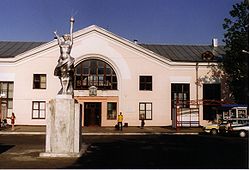Luninyets District

Luninyets District Лунінецкі раён (Belarusian) | |
|---|---|
 | |
| Coordinates: 52°15′07″N 26°47′32″E / 52.25194°N 26.79222°E | |
| Country | Belarus |
| Region | Brest Region |
| Formed | 1940 |
| Administrative center | Luninyets |
| Area | |
| • District | 2,708.51 km2 (1,045.76 sq mi) |
| Population (2024)[1] | |
| • District | 61,728 |
| • Density | 23/km2 (59/sq mi) |
| • Urban | 35,814 |
| • Rural | 25,914 |
| Time zone | UTC+3 (MSK) |
| Website | luninets |
Luninyets District or Luniniec District[2] (Belarusian: Лунінецкі раён; Russian: Лунинецкий район) is a district (raion) of Brest Region in Belarus. Its administrative center is Luninyets.[1] As of 2024, it has a population of 61,728.[1]
Demographics
[edit]
At the time of the 2009 Belarusian census, Luninets District had a population of 73,200. Of these, 96.2% were of Belarusian, 2.5% Russian and 0.8% Ukrainian ethnicity. 76.8% spoke Belarusian and 21.9% Russian as their native language. In 2023, it had a population of 62,544.[3]
Notable residents
[edit]- Anton Sokał-Kutyłoŭski (1892 (Pieravaloki-Darahišča (renamed Čyrvonaja Horka)) - 1983), active participant in the Belarusian independence movement, a military leader of anti-Soviet resistance in the early 20th century and a Gulag prisoner.[4]
- Sviatlana Tsikhanouskaya (b.1982, Mikashevichy), Belarusian human rights activist and politician[5]
References
[edit]- ^ a b c "Численность населения на 1 января 2024 г. и среднегодовая численность населения за 2023 год по Республике Беларусь в разрезе областей, районов, городов, поселков городского типа". belsat.gov.by. Archived from the original on 2 April 2024. Retrieved 6 May 2024.
- ^ Official transliteration from Belarusian language (2007)
- ^ "Численность населения на 1 января 2023 г. и среднегодовая численность населения за 2022 год по Республике Беларусь в разрезе областей, районов, городов, поселков городского типа". belsat.gov.by. Archived from the original on 17 April 2023. Retrieved 13 August 2023.
- ^ Арлоў, Уладзімер (2020). ІМЁНЫ СВАБОДЫ (Бібліятэка Свабоды. ХХІ стагодзьдзе.) [Uładzimir Arłou. The Names of Freedom (The Library of Freedom. ХХІ century.)] (PDF) (in Belarusian) (4-е выд., дап. ed.). Радыё Свабодная Эўропа / Радыё Свабода - Radio Free Europe/Radio Liberty. pp. 346–347.
- ^ Svetlana Tikhanovskaya: from 'Chernobyl child' in Ireland to political limelight


